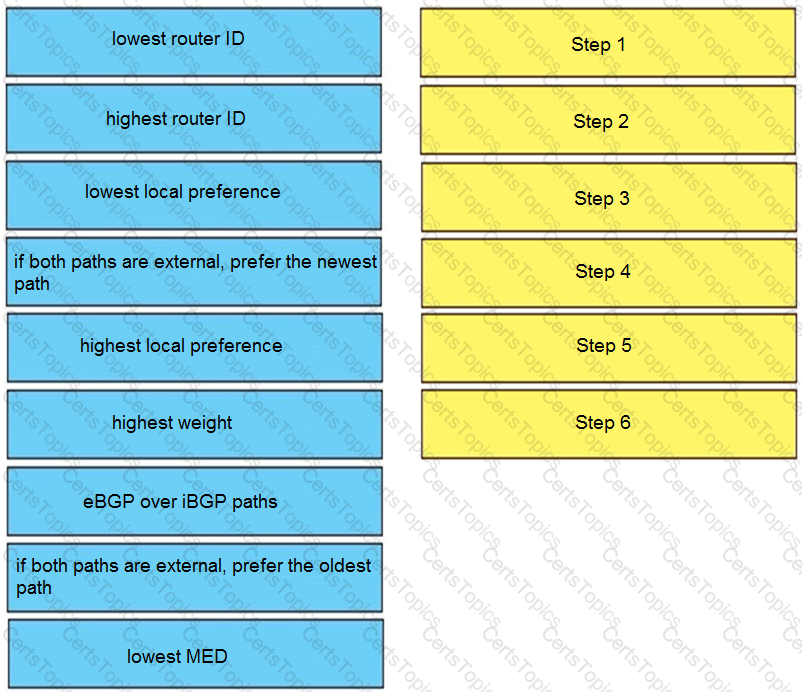Refer to the exhibit.

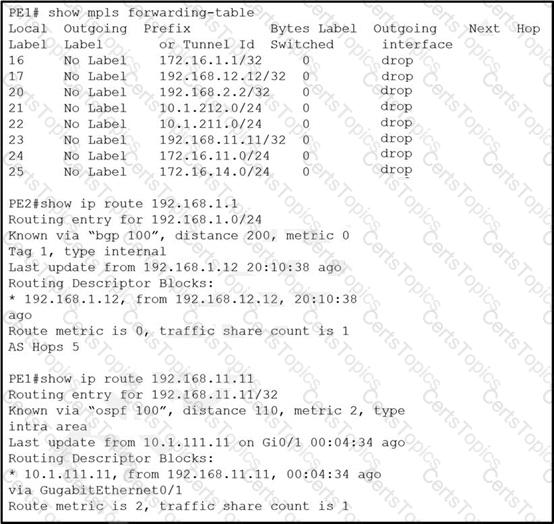
VPN users that are connected to PE routers are facing network issues. Traffic that originates from CE1 drops before reaching CE2. An engineer finds no outgoing traffic statistics on PE1 and PE2 routers toward CE devices and finds that the PE1 router is running the older software image. Which action must be implemented to resolve the issues?
Drag and drop the features about multicast from the left onto the multicast protocols on the right. Not all options ate used.
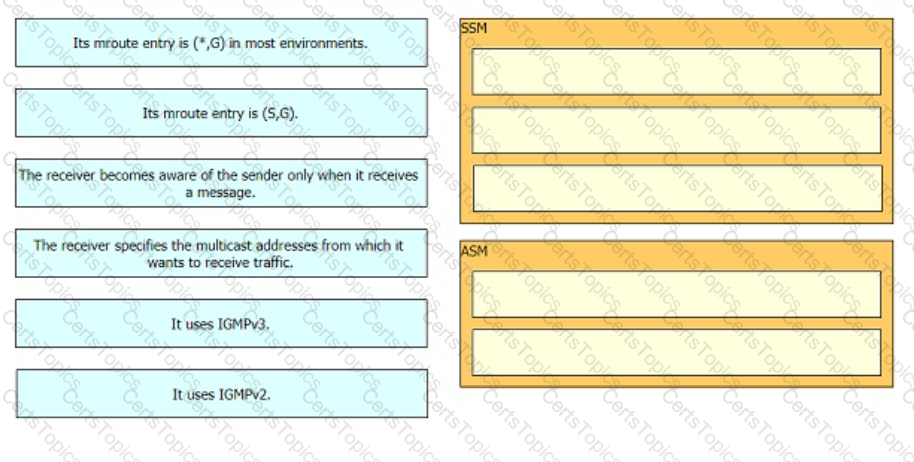
Refer to the exhibit.
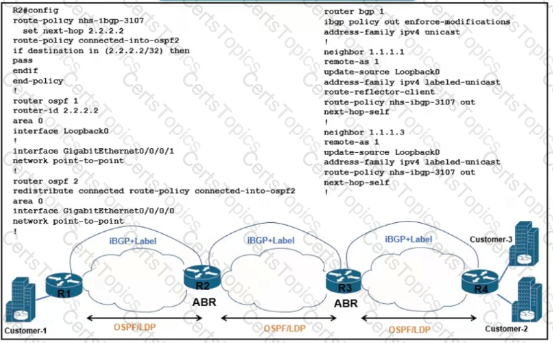
There is a connectivity issue between Customer-1 and Customer-2 File servers between the customers cannot send critical data R3 routes are missing from the routing table on the Customer-1 router All interlaces on Customer-1 are up Which configuration must be applied to router R2 to correct the problem?
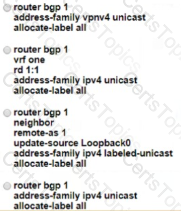
Refer to the exhibit
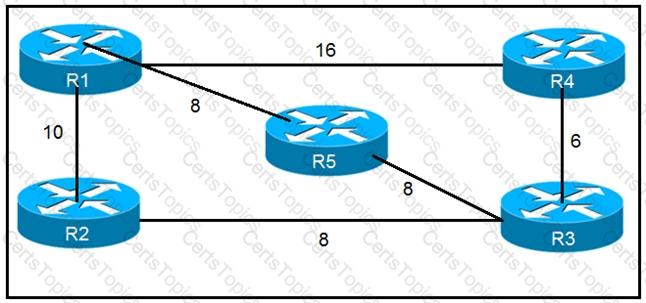
Which router does R1 install as an alternate next hop when trying to reach R3 if LFA is
enabled?
Refer to the exhibit.
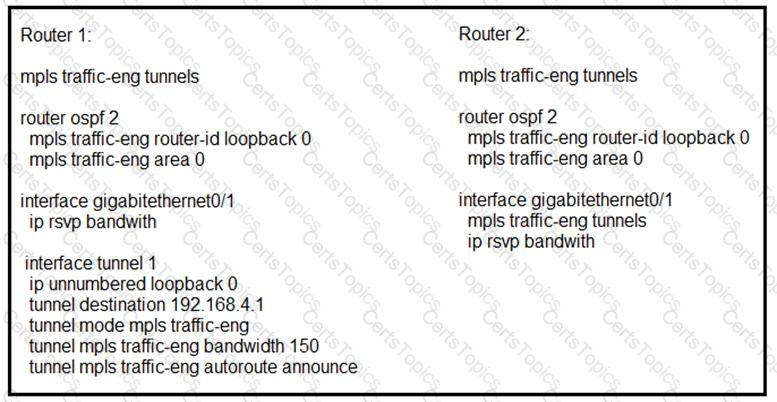
Router 1 has attempted to establish a Cisco MPLS TE tunnel to router 2, but the tunnel
has failed. Which statement about this configuration is true?
After you change the IP address on an IOS XR router, you cannot ping the new address.
Which step did you forget to complete?
Refer to the exhibit.
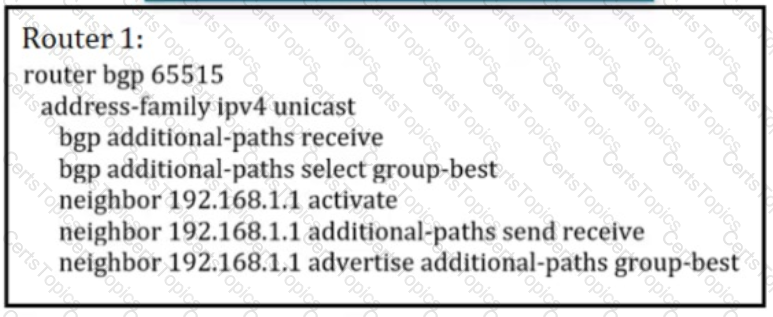
An engineer working for a private telecommunication company with an employee id 3977 74 814 implemented the configuration on Router 1. what is the effect of it?
Refer to the exhibit.


VPN users that are connected to PE routers are facing network issues. Traffic that originates from CE1 drops before reaching CE2. An engineer finds no outgoing traffic statistics on PE1 and PE2 routers toward CE devices and finds that the PE1 router is running the older software image. Which action must be implemented to resolve the issues?
What can be used to determine a path from the head-end to a tail-end router when implementing SR-TE with a head-end, with little information on the network topology?

Refer to the exhibit. Company A established BGP sessions with several ISPs. A network engineer at the company must filter out all traffic except for routes that transit AS 152. The engineer configured the filtering policy “permit _152S_(_[0.9])” on R1, but after applying the configuration, the engineer notices that other routes are still visible. Which action resolves the issue?

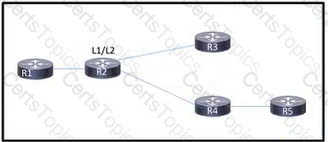
Refer to the exhibit Reuters R2. R3, R4 and R5 all reside in the same area, with R1 in a different area R3 is overutilized and the engineer wants to reduce its CPU load The engineer configured router R4 to summarize routes that it receives from R5. but R3 is still receiving all of the R5 routes. Which action resolves the issue?
Refer to the exhibit.
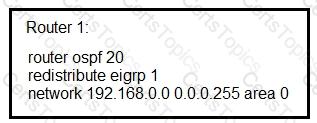
An engineer is troubleshooting an OSPF issue. Router 1 has a neighbor relationship with
router 2. Only router 1 classful EIGRP routes can be seen on router 2. In order for all EIGRP routes to be redistributed correctly, which action should be taken?
For which reason do you deploy BGP confederations within a BGP transit backbone?
A network consultant is troubleshooting IS-IS instances to identify why a routing domains is having communication problems between the two instances. Which description of the possible cause of issues in the routing domain is true?
Refer to the exhibit.
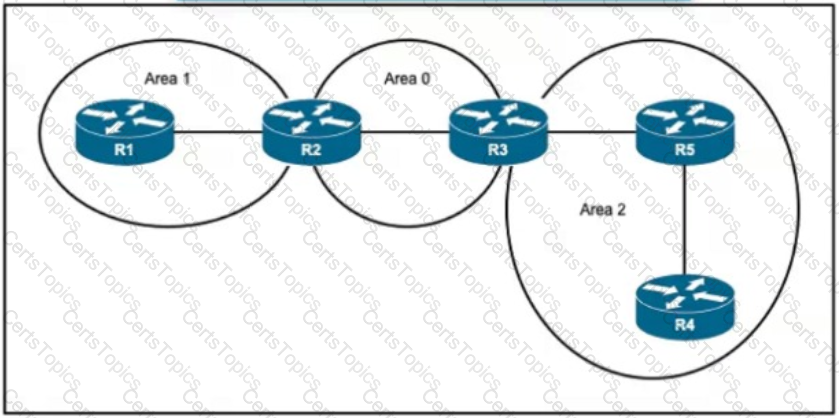
A network engineer applied configuration on R5 to summarize all OSPF routes, but R4 is still receiving specific routes from R5. The engineer has confirmed that both R5 and R4 routers are configured with correct summarization configuration but R5 Is not sending the summary routes What action must the engineer take to fix the problem?
Refer to the exhibit.
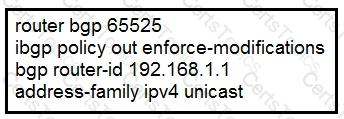
Router 1 is a core ABR in a Cisco Unified MPLS environment. All of the router 1 BGP
peers are established, but traffic between customers is failing. Which BGP configuration must be added to the configuration?
Which two routing protocols have extensions capable of running SRv6? (Choose two.)
Refer to the exhibit.
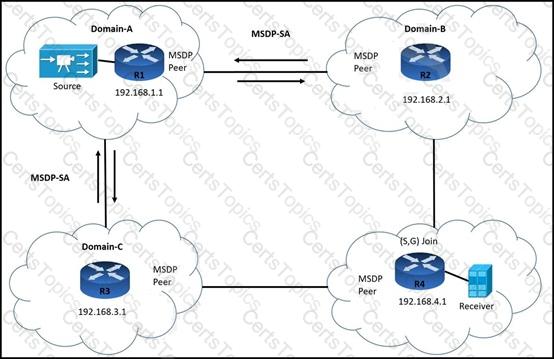
R3 is:
Which command must the engineer implement to resolve the issue?
A R3# ip msdp sa-filter in 192.168.3.1
B. R3# no ip msap sa-filter in 192.168.1.1
C R3# no ip msdp peer 192.168.1.1
D. R3# ip msdp sa-filter out 192.168.1.1
Refer to the exhibit.

After troubleshooting an OSPF adjacency issue, routers 1, 2, and 3 have formed OSPF
neighbor relationships. Which statement about the configuration is true?
After an engineer configures BGP in R1, it starts receiving this message
*Jun 29 13:30:50.122: %BGP-5-ADJCHANGE: neighbor 192.168.10.1 Down User reset
Jun 29 13:30:52.341: %BGP-3-NOTIFICATION: sent to neighbor 192.168.10.1 2/6 (unacceptable hold time) 0 bytes
Which action makes the peering come back up again?
Refer to the exhibit.
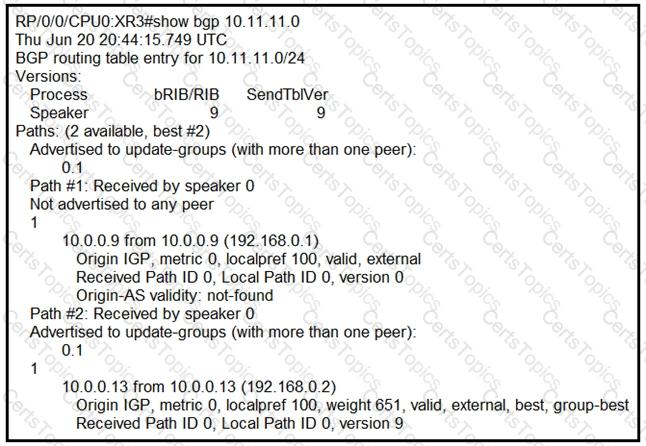
A network operator is getting the route for 10.11.11 0/24 from two upstream providers on
#XR3. The network operator must configure #XR3 to force the 10.11.11.0/24 prefix to route via next hop of 10.0.0.9 as primary when available. Which of these can the operator use the routing policy language for, to enforce this traffic forwarding path?
Refer to the exhibit.
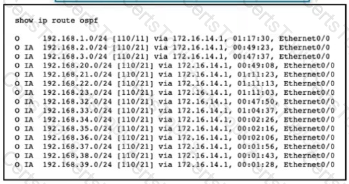
An engineer applied the summarization configuration on R1 for four networks (192.168.20.0/24 to 192.168.23.0/24) in area 1 and eight networks (192.168.32.0/24 to 192.168.39.0/24) in area 2 to stop the flooding of all the customer routes. While checking the routing table of R2, the engineer noticed that R1 is still sending only specific routes to R2. Which configuration should the engineer apply on R1 to summarize routes?
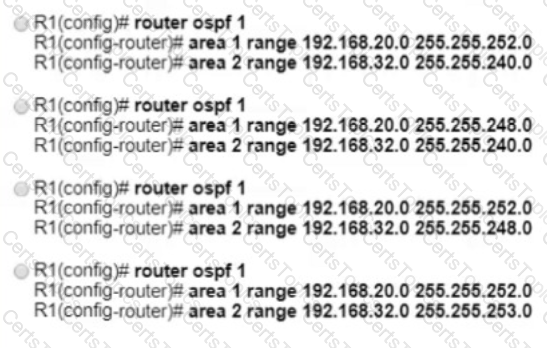
Refer to the exhibit.

An engineer applied the summarization configuration on R1 for four networks (192.168.20.0/24 to 192.168.23.0/24) in area 1 and eight networks (192.168.32.0/24 to 192.168.39.0/24) in area 2 to stop the flooding of all the customer routes. While checking the routing table of R2, the engineer noticed that R1 is still sending only specific routes to R2. Which configuration should the engineer apply on R1 to summarize routes?

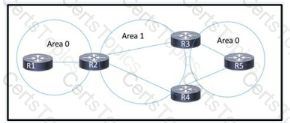
Refer to the exhibit. A network engineer just replaced five routers on this OSPF network. When the routing protocol is brought up, R5 cannot reach routes that originate on R1. The engineer verified that all connected links have established neighbor relationships. R5 reaches routes originating on R3 and R4. Which action resolves the issue?
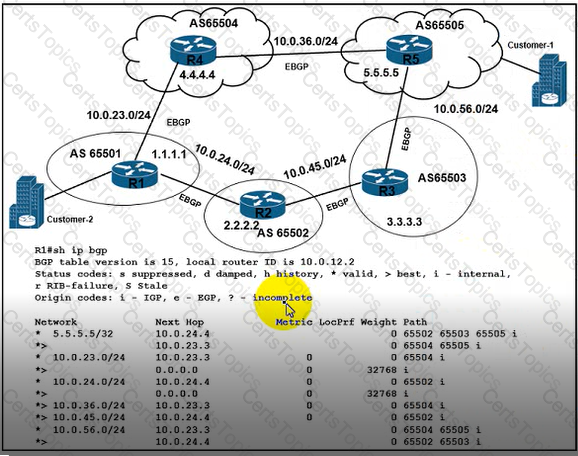
Refer to the exhibit There is a BGP traffic path issue between Customer-1 and Customer-2 Users from Customer-2 have reported file transfer issues High utilization on the path between both customers causes many packet drops. Which configuration resolves the issue?
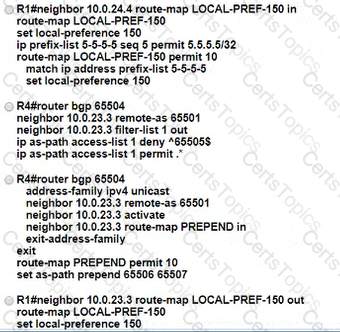
Refer to the exhibit.
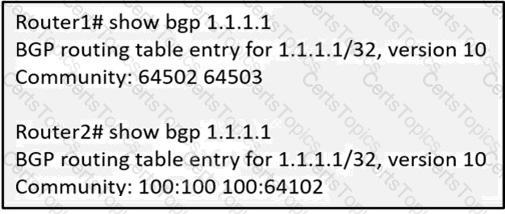
An engineer working on a client’s network is trying to solve the BGP community issue on R1 and R2 routers. After displaying the BGP entries, the engineer notices that both routers still have different outputs. Which action must the engineer perform to any of the routers to correct the problem and get the same output?
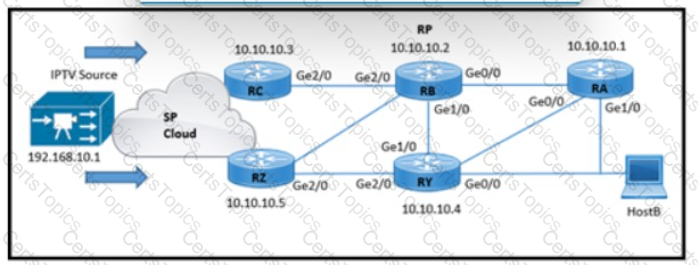
Refer to the exhibit. HostB receives an IPTV traffic stream from the multicast source at 192.168 10.1. When router RB is powered down, it impacts multicast traffic forwarding to downstream peers. The RA and RB routers reside in the same physical location. Which two configurations must be implemented so that HostB receives the multicast stream even when RB is powered down? (Choose two )

Refer to the exhibit A network engineer installed a new router (router 3) at the regional hub running MPLS services for scalability Router 3 is connected to the 10.44 4.0,'24. 10.44 5.024. 10 44.6.0/24. and 10 44 7 0/24 subnets The new router has been configured for OSPF area 2. and it is advertising the four connected networks. The engineer noticed that the same networks are listed as interarea summary routes, and they are being flooded into each area on the area borders Which action resolves the issue?
Which difference should be considered when intradomain or interdomain multicast routing is implemented?
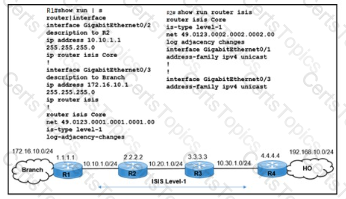
Refer to the exhibit. Users at the branch office on R1 reported issue with an application at the home office on R4. While troubleshooting the issue, a network engineer determined that
Which action resolves the issues?
Refer to the exhibit.
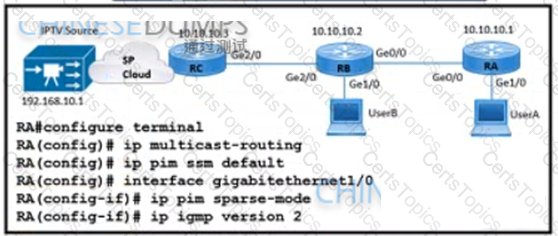
The UserA device fails to recede IPTV streaming traffic from the source While debugging the issue a network engineer finds that routers RB and RC receive the multicast traffic normally RC receives subscription messages from UserA to join the IPTV stream Which action must the engineer lake on router RA to correct this problem?
What can be used to determine a path from the head-end to a tail-end router when implementing SR-TE with a head-end, with little information on the network topology?
For which reason can two devices fail to establish an OSPF neighbor relationship?
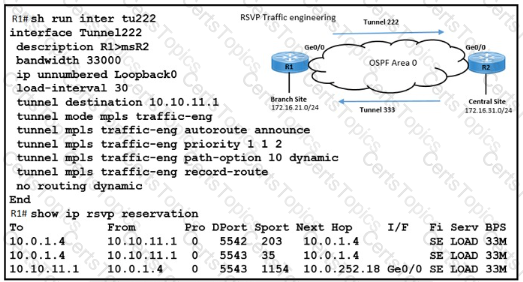
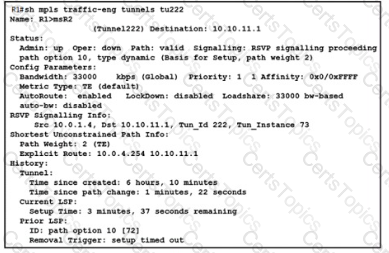
Refer to the exhibit. A network engineer is investigating a report of packet drops between the branch site and the central site.
Which configuration corrects the packet-drop problem?
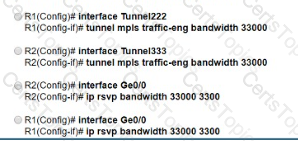
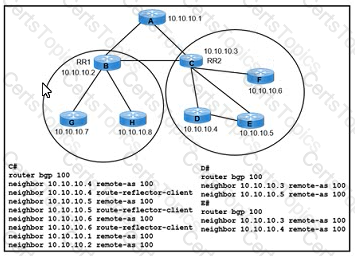
Refer to the exhibit While troubleshooting a networking issue an engineer identified a suboptimal communication issue on route reflector RR2 In the current environment
Which action resolves the issue?
Refer to the exhibit.
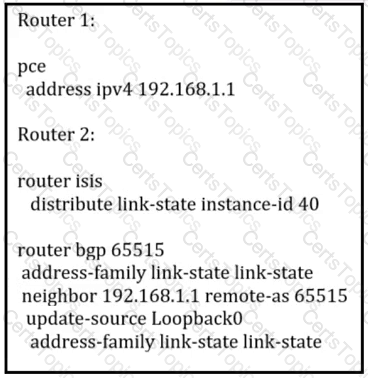
What is the relationship between Router 1 and Router 2?
Refer to the exhibit.

Which task must you perform on interface g1/0/0 to complete the SSM implementation?
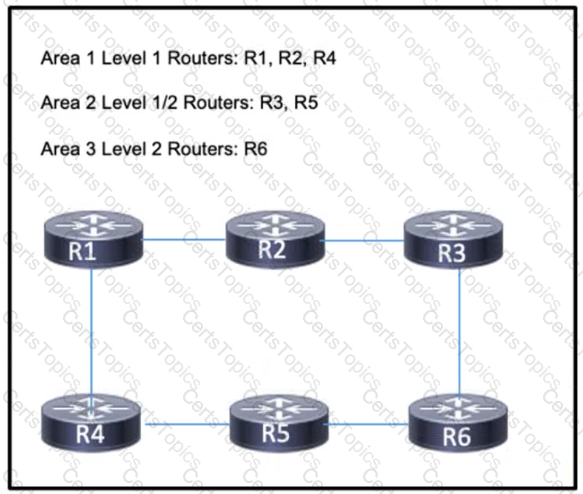
Refer to the exhibit. An engineering team implemented IS-IS on the network, with several different areas. Recently, router R6 in area 3 has been experiencing excessive CPU usage. To reduce the load, a network engineer implemented route summarization on R2 However. R6 is still receiving the full routes from all routers. Which action must the engineer take to resolve the excessive CPU usage?

Refer to the exhibit. An engineer is troubleshooting an issue with this network and notices that prefixes from R3 are missing on the R1 routing table Due to repeated ASN when the 10 0 0 0'8 prefix from R3 arrives at R1, BGP automatically rejects it There is no prefix-list on R1 which blocks the traffic from R3 What should the engineer do to fix the problem so that BGP allows that prefix on R1?
Refer to the exhibit.
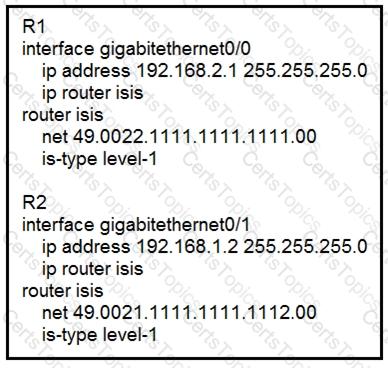
Routers R1 and R2 cannot form a neighbor relationship, but the network is otherwise
configured correctly and operating normally. Which two statements describe the problem? (Choose two.)
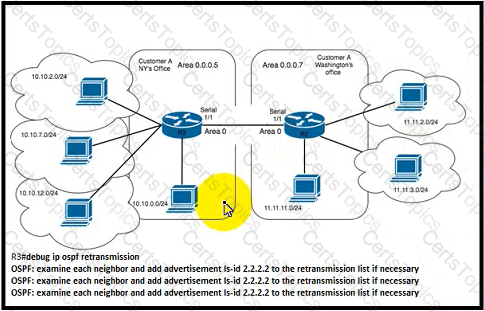
Refer to the exhibit. Customer A is a small media company with two offices connected by a 512 Kbps line. Their NY office is connected to several external partners by static routes on router R3. VoIP services use VoIP codec G729 Users reported poor voice quality and slow data transfer between the offices A network engineer configured ip tcp header-compression iphc-format on R2 and R3 routers Which additional action must the engineer take to fix the issue?
A network engineer is troubleshooting OSPF multiarea. Which Cisco IOS XR feature should the engineer use in order to streamline OSPF issue?
You have configured routing policies on a Cisco IOS XR device with routing policy language. Which two statements about the routing policies are true? (Choose two.)
Which two differences should be considered when deciding whether to implement to implement routing policies or route maps? (Choose two.)
Refer io the exhibit.
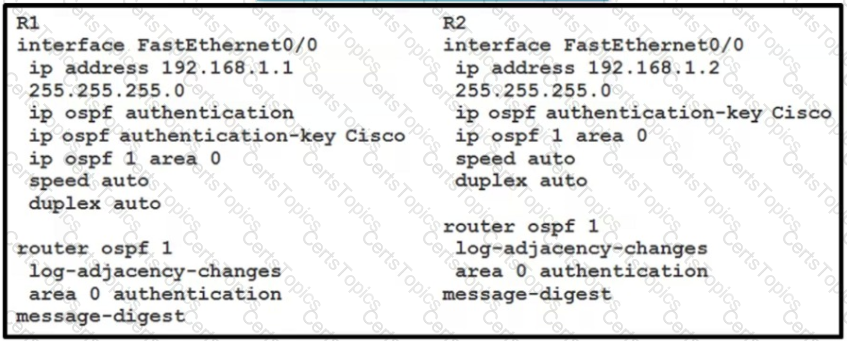
While applying the configurations on two routers an engineer notices that OSPF adjacency Between them remains down Through the ping test the engineer confirmed that both me routers have Layer 3 reachability between them Which action should me engineer take to make the adjacencies to full?
Refer to the exhibit.

There is a connectivity issue between Customer-1 and Customer-2 File servers between the customers cannot send critical data R3 routes are missing from the routing table on the Customer-1 router All interlaces on Customer-1 are up Which configuration must be applied to router R2 to correct the problem?

Refer to the exhibit.
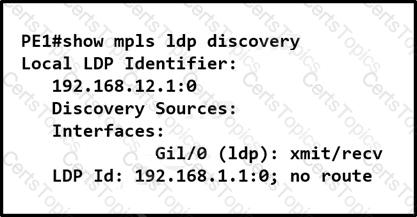
An administrator is troubleshooting network issues on a customer’s network PE1 cannot form an LDP relationship with PE2 using LDP ID 192 168.1.1. Due to this connectivity issue, the customer’s routes behind both PE routers cannot be exchanged. Which action must the administrator take to correct the problem?
Refer to the exhibit
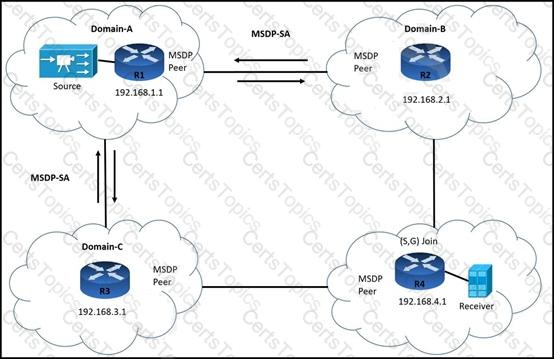
Router R1 is configured to advertise outgoing SA messages to routers R2 and R3, but to receive incoming SA messages only from R2. Which additional configuration must an engineer apply to router R1 so it filters all MSDP SA messages from Domain-C?
Refer to the exhibit.
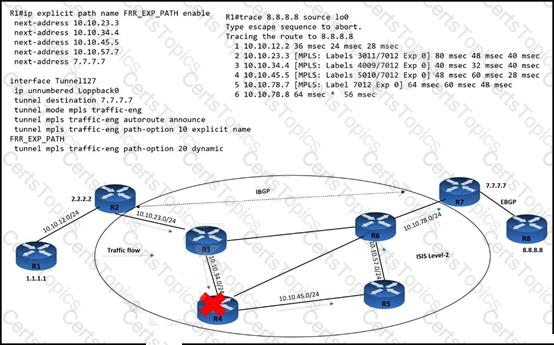
An MPLS core network has connectivity issues R4 has failed. It impacts traffic loss between R1 and R8. Customers report no access to their file servers, which delays their transformation work. Which quick action resolves the issue until R4 recovers?
Refer to the exhibit.
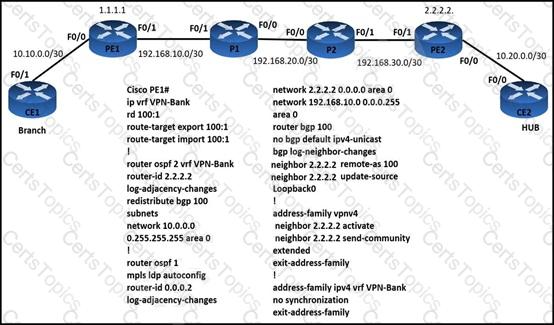
Customer traffic from the branch site to the hub is experiencing packet drops. The engineer verified that:
Which action resolves the issue?
An engineer is troubleshooting slow performance issues on a customer’s network after the last multicast configuration change was applied on it While checking the running configuration on the router the engineer notices there are many ip igmp join-group commands applied on several interfaces of the router which caused the high CPU utilization usage. What action must the engineer take to solve this issue?
Which two BGP route reflector attributes should be implemented to prevent routing loops? (Choose two)
Refer to the exhibit.

What is the relationship between Router 1 and Router 2?
What are two features of dual-stack? (Choose two.)
Refer to the exhibit.
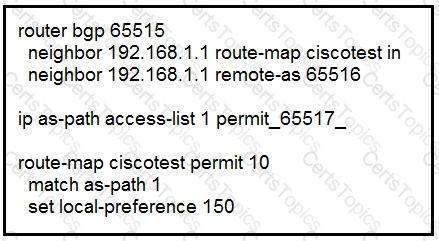
After troubleshooting BGP traffic steering issue, which action did the network operator
take to achieve the correct effect of this configuration?
Refer to the exhibit.
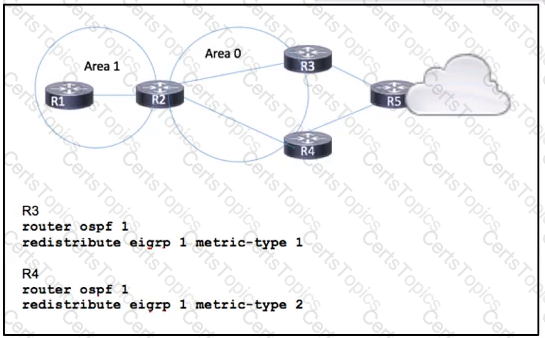
Routers R1, R2. R3, and R4 have been configured to run OSPF. and router R5 is running EIGRP Traffic from R1 to R5 is expected to pass via R4. but OSPF routing has calculated the best path via R3. Which action corrects the problem?
Refer to the exhibit.

Why is neighbor 10.1.5.5 stuck in “2WAY” state?
Refer to the exhibit.

Customer traffic from the branch site to the hub is experiencing packet drops. The engineer verified that:
Which action resolves the issue?
What is the difference between basic IS-IS and OSPF packet types?
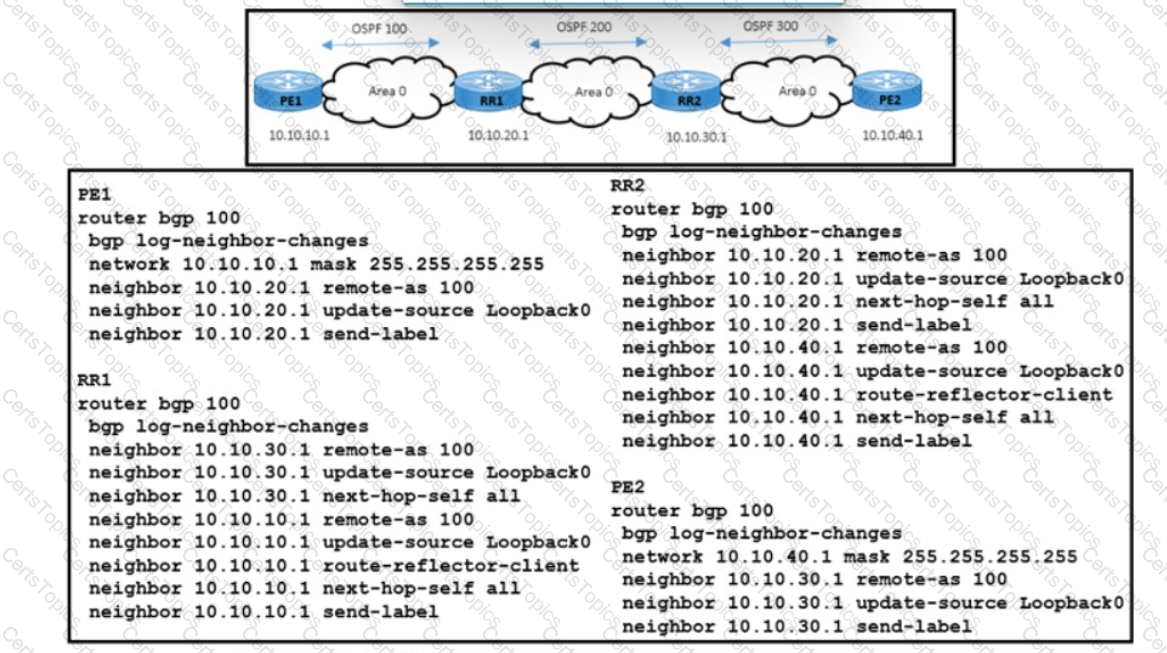
Refer to the exhibit. A network engineer is investigating a report of packet drops in an application running on a server connected to PE2 The engineer determined that:
Which action resolves the issue?
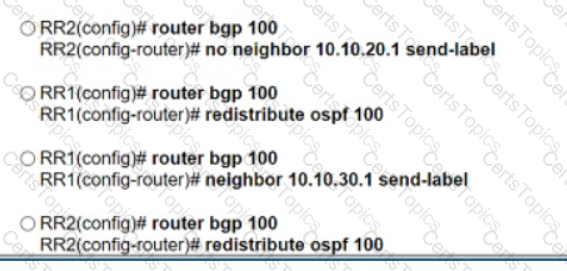
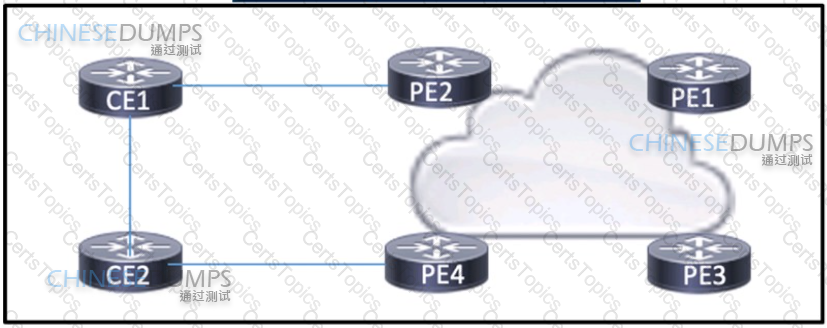
Refer to the exhibit. Company X is multihomed to a service provider. With the default settings, the link between PE2 and CE1 is the primary link, but company X has asked for the link between PE4 and CE2 to operate as the primary instead. A network engineer used a route map with local-preference to manipulate the routes from PE2 to CE1 to be less desirable and applied the route map on PE2 outbound to CE1. However, the path from PE2 to CE1 is still preferred. Which action must the engineer take so that the desired path is chosen?

Refer to the exhibit. The Cisco router has a single uplink to the upstream network, which is critical to the business. The router is configured for traffic steering with the Autoroute mechanism configured to steer all OSPF and IS-IS prefixes over non-shortest paths and divert traffic for those prefixes to the SR-TE policy. However, the Autoroute Announce functionality for all prefixes is not working. Which additional command set must the engineer configure on the router to correct this issue?
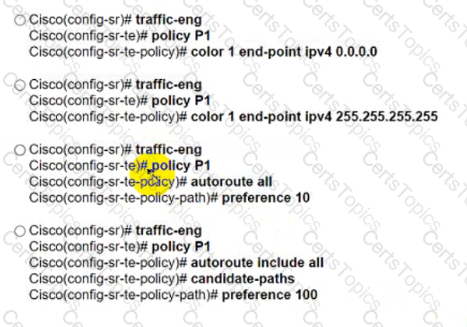
Drag and drop the attributes for the BGP route selection on the left into the correct order on the right. Not all options are used.
